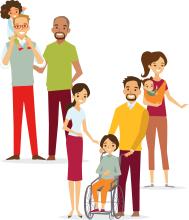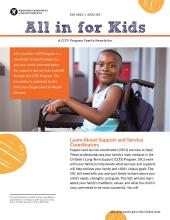Children’s Long-Term Support: Program Information for Families
The Children’s Long-Term Support (CLTS) Program helps children with disabilities and their families through supports and services that help children grow and live their best lives in their home and community.
We know that parents and caregivers may need extra support. Working with you, the program helps your child get what they need. Learn more about the program and find family resources on this page.
Share your input
You are invited to join an online input session in September to share your ideas for how to improve the CLTS Program!
Essential children's resources
Wisconsin Wayfinder supports families of children with delays, disabilities, special health care needs, and mental health conditions. Children’s resource guides are helpers who assist families, caregivers, professionals, and organizations in finding a wide array of supports and services available through the Children’s Resource Network.
Your team
When you enroll in CLTS, you work with a team. The team includes:
- Your child.
- Your family (parents, caregivers) and others you want to be involved.
- Wisconsin Department of Health Services (DHS).
- The county health and human services agency near you.
- Your child’s provider(s).
The team helps you apply for and get the right supports and services. Everyone works to support your child with their needs. Each member plays a role:
DHS
DHS supports the program at the state level. We work with county agencies in all 72 counties. State teams help provide information and support to families, county programs, and community partners.
You can contact DHS at the Bureau of Children's Services (BCS) Technical Assistance Center at DHSBCSTAC@dhs.wisconsin.gov or 608-267-6767.
Your county agency
All counties in Wisconsin have a county health and human services agency. The local county agency works directly with families in the CLTS Program. They connect you with a support and service coordinator (SSC). This person is your one-on-one partner and main contact. They can help you:
- Apply for the CLTS Program.
- Answer questions.
- Get supports and services.
Providers
The CLTS Program pays providers that help children with disabilities and their families. Providers work with children and families to help them meet their goals. View a list of the CLTS-covered supports and services.
Search for a provider using the provider directory. After you find a provider, talk to the SSC. They can tell you more about how to get services from that provider.
Deciding together
We know that you’re the expert on your life. This means you should lead decisions about what will best support your family and child. Deciding Together is a team approach to help find the right supports and services for your family and child.
Team members will use Deciding Together to learn more about your child and family and how to best support. All decisions made about your child’s supports and services should be based on your family's and child’s unique needs and goals identified through the Deciding Together approach.
View the Deciding Together materials to learn more.
Your rights
Families who are in the CLTS Program have rights that help each child receive supports and services fairly. You have the right to:
- Review the Participant Rights and Responsibilities Notification, F-20985. If you have questions about this form, contact the SSC.
- Appeal or file a grievance about the program. If you don’t agree with or don’t understand a decision, you can:
- Talk with the SSC.
- Ask questions at any time.
- Request an appeal through the State Division of Hearings and Appeals.
- Complete the county’s grievance process. Contact your county agency for more details.
Related topics
We have pages on our website that explain:
- Supports and services we cover
- Who can join
- How to apply
- Program costs (parental payment limits)
- The enrollment process
View the Welcome to the Children’s Long-Term Support Program, P-03010. It’s a guide for new families.
These files have more details about the program:
Sign up to get the latest program news, highlights, tips, and more about the CLTS Program or the Birth to 3 Program.
Want to be more active in the program?
- Keep up with Children’s Long-Term Support Waiver Renewal.
- Stay in the know about the CLTS Program for the 2027–2031 cycle.
- Learn about the family input sessions and survey.
- Join the council. Come to a council meeting. You also can apply to be a member and give direct feedback.
Learn about some of our partners:



